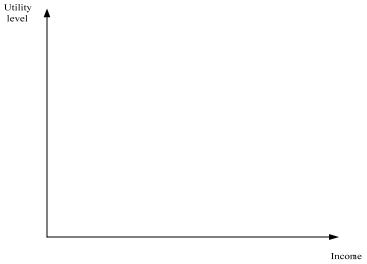Part 1 - Choice under uncertainty
Let us assume that your utility function is given by U = √I . You have been offered two wage offers.
- In the first one you will receive a fixed salary of $54,000.
- In the second one, you will only receive $4,000 as a fixed payment, plus a bonus of $100,000 if the firm goes profitable. The probability that the firm goes profitable (and you get a total of $104,000 that year) is 0.5, while the probability that the firm does not make enough profits is 0.5.
a) Find the expected value of the lottery induced by accepting the second wage offer.
b) Find the expected utility associated with the second offer.
c) Draw an approximate figure where the following elements are clearly illustrated:
- Utility function (either concave, linear or convex)
- Utility level (in the vertical axis) from the first wage offer.
- Utility level (in the vertical axis) from each of the two possible outcomes of the second wage offer.
- Expected utility level from the second wage offer.

d) Using your answers from parts (a) and (b), find the risk premium associated with the second offer.
e) What amount of money should the first wage offer propose you in order to make you exactly indifferent between accepting the first and the second wage offers?
f) In your figure from part (c) include the risk premium of the second wage offer.
Part-2
Question 1:
Suppose a monopoly market has a demand function in which quantity demanded depends not only on market price (P) but also on the amount of advertising the firm does (A, measured in dollars). The specific form of this function is
Q = (20 - P)(1+ 0.1A +0.01A2)
The monopolistic firm's cost function is given by
C = 10Q + 15 +A
a. Suppose there is no advertising (A=0). What output will the profit maximizing firm choose? What market price will this yield? What will be the monopoly's profits?
b. Now let the firm also choose its optimal level of advertising expenditure. In this situation, what output level will be chosen? What price will this yield? What will the level of advertising be? What are the firm's profits in this case?
Question 2:
Consider the following Bertrand game involving two firms producing differentiated products.
Firms have no costs of production. Firm 1's demand is
q1 = 1 + p1 + bp2
where b > 0. A symmetric equation holds for firm 2's demand.
a. Solve for the Nash equilibrium of the simultaneous price-choice game.
b. Compute the firm's outputs and profits.
c. Represent the equilibrium on a best-response function diagram. Show how an increase in b would change the equilibrium. Draw a representative isoprofit curve for firm 1.
Question 3:
Suppose there are only two individuals in society. Person A's demand curve for mosquito control is given by
qn = 100 - p
For person B, the demand curve for mosquito control is given by
qb = 200 - p
a. Suppose mosquito control is a pure public good; that is once it is produced, everyone benefits from it. What would be the optimal level of this activity if it could be produced at a constant marginal cost of $120 per unit?
b. If mosquito control were left to the private market, how much might be produced? Does your answer depend on what each person assumes the other will do?
c. If the government were to produce the optimal amount of mosquito control, how much will this cost? How should the ta- bill for this amount be allocated between the individuals if they are to share it in proportion to benefits received from mosquito control?